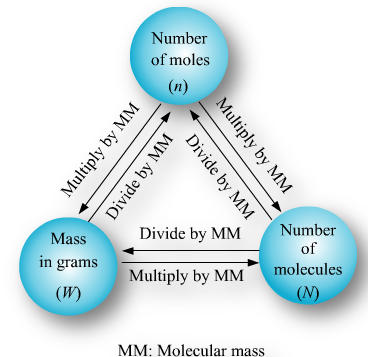Mole Concept – General Science Notes – For W.B.C.S. Examination.
মোল ধারণা – সাধারণ বিজ্ঞান নোট – WBCS পরীক্ষা।
The mole concept is a convenient method of expressing the amount of a substance. Any measurement can be broken down into two parts – the numerical magnitude and the units that the magnitude is expressed in. For example, when the mass of a ball is measured to be 2 kilograms, the magnitude is ‘2’ and the unit is ‘kilogram’.Continue Reading Mole Concept – General Science Notes – For W.B.C.S. Examination.
When dealing with particles at an atomic (or molecular) level, even one gram of a pure element is known to contain a huge number of atoms. This is where the mole concept is widely used. It primarily focuses on the unit known as a ‘mole’, which is a count of a very large number of particles.
The number 6.02214076*1023 is popularly known as the Avogadro constant and is often denoted by the symbol ‘NA’. The elementary entities that can be represented in moles can be atoms, molecules, monoatomic/polyatomic ions, and other particles (such as electrons).
For example, one mole of a pure carbon-12 (12C) sample will have a mass of exactly 12 grams and will contain 6.02214076*1023 (NA) number of 12C atoms. The number of moles of a substance in a given pure sample can be represented by the following formula:
n = N/NA
Where n is the number of moles of the substance (or elementary entity), N is the total number of elementary entities in the sample, and NA is the Avogadro constant.
The word “mole” was introduced around the year 1896 by the German chemist Wilhelm Ostwald, who derived the term from the Latin word moles meaning a ‘heap’ or ‘pile.
The number of moles of a molecule may not always be equal to the number of moles of its constituent elements. For example, a mole of water contains NA number of H2O molecules. However, each water molecule contains 2 hydrogen atoms and one oxygen atom. Therefore, one mole of H2O contains 2 moles of hydrogen and one mole of oxygen.
Atomic and Molecular Mass
The atomic mass of an element is the mass of one atom of the element expressed in atomic mass units (amu). It accounts for the abundance of the various isotopes of the element and assigns an average value to the mass of one atom of the element.
For example, the atomic mass of carbon is 12.011 atomic mass units since carbon samples generally contain 98.89% of the carbon-12 isotope, 1.11% of carbon-13, and trace amounts of carbon-14. However, the atomic masses of these isotopes are different.
The atomic mass of a carbon-12 atom is 12 atomic mass units, but that of a carbon-13 atom is 13 amu. The atomic mass of an element is roughly equal to the sum of all the protons and neutrons present in its nucleus.
The molecular mass of an element is the sum of the atomic masses of all its constituent elements. This quantity is also represented in terms of atomic mass units. Therefore, the molecular mass of water is equal to the sum of the atomic masses of its constituents – hydrogen and oxygen.
The atomic mass of hydrogen is 1.00794 amu and that of oxygen is 15.9994. Since water molecules contain 2 hydrogen atoms and only one oxygen atom, the molecular mass of H2O is 18.0154 amu.
Molar Mass
The molar mass of a substance is defined as the total mass of one mole of the substance. It is often represented in terms of ‘grams per mole’ (g/mol). However, the SI unit of this quantity is kg/mol. Molar mass can be represented by the following formula:
Molar mass of a Substance = (Mass of the Substance in grams)/(Number of Moles)
For example, the molar mass of water is approximately 18.015 g/mol, which is the mass of NA number of water molecules.
For Guidance of WBCS (Exe.) Etc. Preliminary , Main Exam and Interview, Study Mat, Mock Test, Guided by WBCS Gr A Officers , Online and Classroom, Call 9674493673, or mail us at – mailus@wbcsmadeeasy.in
Visit our you tube channel WBCSMadeEasy™ You tube Channel
Please subscribe here to get all future updates on this post/page/category/website



 Toll Free 1800 572 9282
Toll Free 1800 572 9282  mailus@wbcsmadeeasy.in
mailus@wbcsmadeeasy.in


















































































































